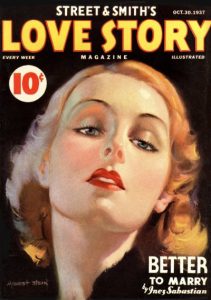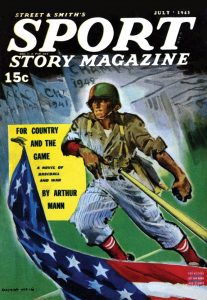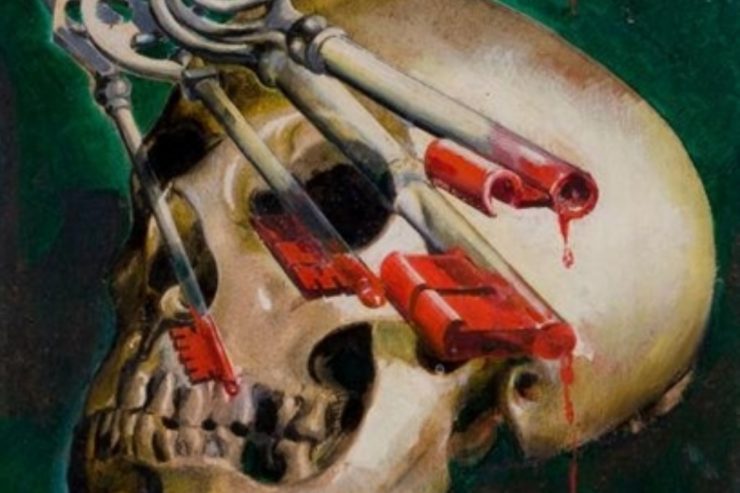Pulp magazines have influenced writers, artists, film directors, software developers, and countless others over the years. Our “PulpFest Historical” articles focus on the rough-paper writers, editors, publishers, and artists who have inspired and continue to inspire the creators of the world’s popular culture.
 LOVE STORY artist Modest Stein is probably best known for the hundreds of covers that he painted for the Street & Smith magazine. His life and art career are a story much larger than his connection to the best-selling romance pulp. In fact, Stein’s artwork was already well known to pulp magazine readers by the time LOVE STORY MAGAZINE was launched in 1921.
LOVE STORY artist Modest Stein is probably best known for the hundreds of covers that he painted for the Street & Smith magazine. His life and art career are a story much larger than his connection to the best-selling romance pulp. In fact, Stein’s artwork was already well known to pulp magazine readers by the time LOVE STORY MAGAZINE was launched in 1921.
Born Modest Aronstam on February 22, 1871, in the Russian Empire’s Kovno Governorate, the boy knew that he wanted to paint. Unfortunately, his pharmacist father did not approve. In 1888, the budding artist emigrated to the United States at the age of seventeen.
Settling in New York City’s Jewish ghetto, Modest “Modska” Aronstam spent his early years in America with his cousin Alexander “Sasha” Berkman and Emma Goldman, Berkman’s lover. The artist’s friends would eventually become leading figures in the anarchist movement of the United States. For a time, Aronstam was also involved with these activities but maintained a much lower profile in the movement.
When Berkman was imprisoned following a botched assassination attempt, Aronstam began to concentrate on his art career, initially as an engraver. He later began to contribute pen and ink drawings to several New York newspapers. Although he moved away from anarchism, the artist kept in contact with both Goldman and his cousin, even after both had been deported to Soviet Russia in 1919.
 In 1907, seeking to distance himself from his past and protect his family, Aronstam changed his name to Modest Stein. Three years later, he began to paint covers for ALL-STORY WEEKLY, THE ARGOSY, THE CAVALIER, and PEOPLE’S FAVORITE MAGAZINE. For the next decade, Stein sold about one cover a month to Munsey or Street & Smith, along with interior art contributions to various pulps. Stein’s covers often illustrated stories by leading authors such as H. Bedford-Jones, Max Brand, Edgar Rice Burroughs, William Wallace Cook, George Allan England, Edgar Franklin, Zane Grey, Fred Jackson, George C. Jenks, A. Merritt, Clarence Mulford, and William Macleod Raine.
In 1907, seeking to distance himself from his past and protect his family, Aronstam changed his name to Modest Stein. Three years later, he began to paint covers for ALL-STORY WEEKLY, THE ARGOSY, THE CAVALIER, and PEOPLE’S FAVORITE MAGAZINE. For the next decade, Stein sold about one cover a month to Munsey or Street & Smith, along with interior art contributions to various pulps. Stein’s covers often illustrated stories by leading authors such as H. Bedford-Jones, Max Brand, Edgar Rice Burroughs, William Wallace Cook, George Allan England, Edgar Franklin, Zane Grey, Fred Jackson, George C. Jenks, A. Merritt, Clarence Mulford, and William Macleod Raine.
By the time he began painting LOVE STORY MAGAZINE covers, Modest Stein had already done countless pulp magazine covers. While painting weekly covers for LOVE STORY MAGAZINE, he also contributed cover art to such Street & Smith magazines as COMPLETE STORIES, DETECTIVE STORY MAGAZINE, FAR WEST ILLUSTRATED, THE POPULAR MAGAZINE, and WESTERN STORY MAGAZINE. He also painted many covers portraying glamourous Hollywood stars for the Street & Smith movie magazine PICTURE PLAY and continued to paint covers for ARGOSY ALL-STORY WEEKLY as well as for MUNSEY MAGAZINE.
Modest Stein will always be closely associated with LOVE STORY MAGAZINE. Week after week, his depictions of the drama between women and men appeared on the magazine’s covers. In the early 1920s, his paintings frequently depicted heroines as weak damsels in distress, shrinking at the sight of a handsome man. But by the early 1930s, Stein’s paintings depicted more adventurous and independent women to mirror the “modern girl” lifestyle that was favored by many LOVE STORY heroines.
 By the late 1930s, Modest Stein’s appearances on the covers of LOVE STORY MAGAZINE began to wane. In 1939, he moved to Hollywood to work in portraiture. He still managed to sell to the pulps, contributing cover art to ASTOUNDING SCIENCE-FICTION, CLUES DETECTIVE STORIES, CRIME BUSTERS, DOC SAVAGE MAGAZINE, LOVE STORY MAGAZINE, NATIONAL MAGAZINE, ROMANTIC RANGE, THE SHADOW, SPORT STORY MAGAZINE, and UNKNOWN. He even did at least one cover for Trojan Publishing’s PRIVATE DETECTIVE STORIES.
By the late 1930s, Modest Stein’s appearances on the covers of LOVE STORY MAGAZINE began to wane. In 1939, he moved to Hollywood to work in portraiture. He still managed to sell to the pulps, contributing cover art to ASTOUNDING SCIENCE-FICTION, CLUES DETECTIVE STORIES, CRIME BUSTERS, DOC SAVAGE MAGAZINE, LOVE STORY MAGAZINE, NATIONAL MAGAZINE, ROMANTIC RANGE, THE SHADOW, SPORT STORY MAGAZINE, and UNKNOWN. He even did at least one cover for Trojan Publishing’s PRIVATE DETECTIVE STORIES.
Although Street & Smith dropped their pulp magazine publications in 1949, Modest Stein continued to paint, focusing on portraits. According to THE NEW YORK TIMES, a few days before his death in 1958, Stein had been awarded the first prize of the Long Island League of Artists for his work.
Modest Stein certainly racked up enough covers to be considered one of the most prolific of all pulp artists. While he is not as well-known as the more famous artists of the pulp world, his legacy is solid. On the 150th anniversary of his birth, we salute Modest Stein and his work. Both will undoubtedly stand the test of time.
For those popular culture enthusiasts who also have an interest in history and geography, the region where Modest Stein was born was part of the Grand Duchy of Lithuania of Poland-Lithuania until 1795, when it was annexed by the Russian Empire. The Governorate was divided into seven districts, including Kovno, which is now named Kaunas, the second-largest city in the country of Lithuania.
Without a doubt, Modest Stein will always be known as the LOVE STORY artist. After all, he contributed hundreds of covers — including the October 30, 1937 number — to the Street & Smith magazine. But long before he began his association with the best-selling romance pulp, Stein began contributing to THE ARGOSY and other Munsey pulps. He continued his association with Munsey after becoming the lead cover artist for Street & Smith’s LOVE STORY MAGAZINE, often contributing cover paintings to illustrate the work of the publisher’s leading writers. A prime example is Stein’s cover painting for the September 5, 1925 issue of ARGOSY ALL-STORY WEEKLY, illustrating part one of the Edgar Rice Burroughs’ serial, “The Red Hawk.”
Just as Modest Stein’s LOVE STORY women evolved from damsels in distress to “modern girls,” so did his painting style. Whereas his work from the teens, twenties, and thirties is marked by its detail and romantic realism, his work during the 1940s seems increasingly fluid and often symbolic. Stein’s cover paintings for the July 1943 number of STREET & SMITH’S SPORT STORY MAGAZINE and THE SHADOW for March 1945 are prime examples of his more mature pulp work.
Laurie Powers is the granddaughter of pulp author Paul S. Powers. She was introduced to the pulp community in 2007 through the publication of PULP WRITER: TWENTY YEARS IN THE AMERICAN GRUB STREET, her grandfather’s memoir of writing for the pulps. She has also edited several collections of her grandfather’s work in various genres, releasing a number of previously unpublished stories. Laurie is the author of QUEEN OF THE PULPS: THE REIGN OF DAISY BACON AND LOVE STORY MAGAZINE, published by McFarland Books in 2019. She also contributed the chapter, “Love on the Newsstands,” to IDW Publishing’s THE ART OF THE PULPS. A resident of Virginia, Laurie was honored with the Munsey Award in 2016.







